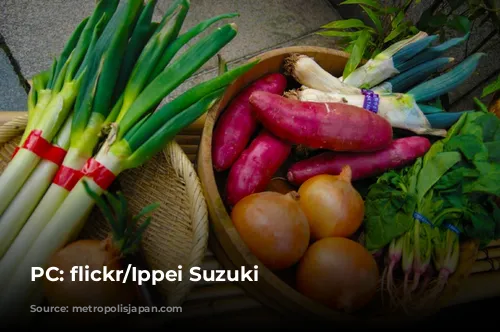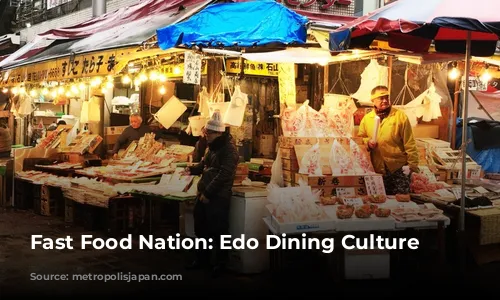Edo, the old name for Tokyo, signifies more than just a city. It marks a pivotal period in Japanese history, known as the Edo Era. This era, characterized by peace and economic prosperity, saw the emergence of a vibrant cultural scene and, importantly, a flourishing culinary culture. Let’s dive into the fascinating story of how Edo’s unique environment shaped its distinctive cuisine.

Edo: The Birthplace of a New Cuisine
The Edo Era witnessed significant changes in Japanese society and lifestyle. The rise of Edo as the new capital of a unified Japan, under the rule of Tokugawa Ieyasu, sparked a population boom and a change in the way people lived. This new, bustling city was home to a diverse mix of people – daimyo (feudal lords), merchants, artisans, and street vendors. This diverse population, coupled with a growing number of bachelors and men working away from their families, created a demand for affordable, quick meals. This gave rise to the yatai, street stalls that provided convenient and delicious food, setting the stage for the unique Edo cuisine we know today.

The Four Kings of Edo Cuisine
The yatai offered a wide array of ready-made meals, including popular breakfast dishes like dried fish, boiled beans, rice, and fried tofu. However, some dishes truly stood out as iconic staples of Edo cuisine: soba, eel, tempura, and sushi. These four culinary stars became synonymous with the flavor of Edo.
Soba, a noodle dish traditionally associated with temples, gained widespread popularity in Edo. Variations like kirisoba, sobagaki, and soba hanamaki became beloved local favorites. Eel, prepared in the kabayaki style, with its unique grilling and basting technique, also became a cherished Edo dish. Interestingly, the way eels were slit, down the back instead of the front, reflects the deep cultural nuances of the time.
Tempura, a dish that originated in Kyoto, underwent a transformation in Edo. The use of sesame oil, in addition to vegetable oil, gave the Edo-style tempura a richer flavor, perfectly complementing the seafood used in this variation. Unlike the simple salt seasoning of Kyoto tempura, Edo tempura was often paired with a mentsuyu dipping sauce, adding another layer of complexity.
Sushi, as we know it today, was born in Edo. The hand-pressed balls of rice topped with seafood known as edomae sushi, evolved to become nigiri sushi, a global culinary sensation. Other popular dishes included dojo (loach) nabe, anago (conger eel), miso, oden, and later, with the lifting of the meat ban, sukiyaki, sakuranabe, and horse meat dishes.
Edo’s Bounty: Seafood and Vegetables
Edo’s cuisine was richly influenced by its surrounding environment. The Edo Sea, teeming with seafood, provided an abundance of fresh ingredients, including flounder, prawns, conger eel, shad, mullet, and rockfish. The Nihonbashi fish market, later to become the famed Tsukiji fish market, served as the heart of Edo’s seafood trade.
Beyond seafood, Edo was also surrounded by fertile agricultural land, yielding a variety of Edo-yasai (Edo vegetables), such as komatsuna, Meguro eggplant, Toshima cucumber, bamboo shoots, and Nerima Daikon. These locally grown vegetables further enriched the flavor and diversity of Edo cuisine.
A Culinary Legacy: Edo Ryori Today
The legacy of Edo ryori lives on in modern Tokyo cuisine. From countless edomae sushi and eel shops to restaurants specializing in Edo cuisine, like Nishiazabu Hide, Sakurada, and Edo Shitamachi Cuisine Miyatogawa, the spirit of Edo’s culinary heritage is alive and thriving. Even Edo-yasai, once in decline, have seen a resurgence thanks to efforts to revive heritage varieties.
The story of Edo ryori is a testament to how culture, history, and environment can shape a cuisine. It is a culinary journey through time, a reflection of the vibrant life of Edo, and a window into the rich flavors of Tokyo today.

